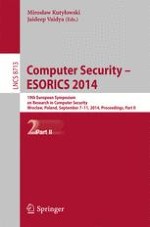The two-volume set, LNCS 8712 and LNCS 8713 constitutes the refereed proceedings of the 19th European Symposium on Research in Computer Security, ESORICS 2014, held in Wroclaw, Poland, in September 2014 The 58 revised full papers presented were carefully reviewed and selected from 234 submissions. The papers address issues such as cryptography, formal methods and theory of security, security services, intrusion/anomaly detection and malware mitigation, security in hardware, systems security, network security, database and storage security, software and application security, human and societal aspects of security and privacy.
